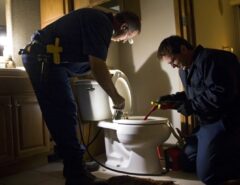Insulating your home’s roof and maintaining its gutters, fascias, and soffits is a task that goes mostly unnoticed. But it is essential for your home’s comfort and energy efficiency.
Insulation
Insulation is the material that keeps heat, sound, and electricity from spreading. It is the reason your thermos of hot chocolate stays warm when it’s cold outside, or your ice chest holds your drinks cool when you’re at the beach.
Quality insulation slows the passage of thermal energy through the walls and roof of your home, preventing excessive heating in winter and cooling in summer. It saves energy and cuts your energy bills.
It also helps maintain a consistent indoor temperature, which means less shivering in the cold and sweating in the heat. Excessively cold or hot temperatures can suppress your immune system and cause discomfort, fatigue, and illness.
Insulation is available in various materials and can be used in different applications. For instance, fiberglass batts are usually a good choice for existing homes, while spray foam is best for new construction and open framing situations. Some insulation materials are environmentally friendly and made from recycled products.
Gutters
Gutters and their enclosed downspouts protect your roof, walls, and foundation from water damage, keeping moisture away from your basement and crawl space. It prevents costly repairs, keeps your home’s structure intact, and helps preserve the health of your landscaping.
Rainwater, melting snow, and ice slide off your home’s roof by gravity. Without gutters, this water can pour over the foundation and cause cracks, seepage, and flooding. It can also erode soil around your home’s base, damaging the foundation and creating holes in the basement wall. It can even eat through fascia boards, soffits, and siding.
A gutter system consists of half pipes that run along the eave edges of your house. A curved piece called a downspout sits at the end of each gutter and dumps rainwater onto a splash block. Then, the piping carries the water to the ground and into a drain or the lawn. It prevents the uncontrolled flow of rainwater and lets homeowners control how it drains from their property.
Fascias
Fascia, or fascia boards, are long straight boards found at the roof’s edge and fixed directly to the rafters. They help support the bottom row of roof tiles and direct guttering away from the house. They also do two other vital jobs: offer a finish to the building and prevent moisture intrusion.
The most popular kind of fascia is often composed of wood, which can be painted or stained to match the design of a building. However, it is prone to rot, so it must be periodically replaced. Materials like aluminum and uPVC are also commonly used, providing an aesthetic finish and resisting rot and weather damage. Did you know fascias are crucial in safeguarding your home’s interior and roofing system? It’s true! Whether made of wood, vinyl, or any other material, their primary function is to protect your house. However, keeping them free of debris and leaves is crucial to ensure that they do this job effectively. By doing so, you can enhance their performance and extend their lifespan. They will also protect the rafters from moisture ingress and ensure water is directed to where it belongs outside.
Soffits
Soffits, which run along the underside of roof overhangs, are vital to your home’s weather protection system. They prevent moisture buildup, protect rafters from weather damage, and guide water away from the roof and home. They also help regulate attic air flow, which is essential for home temperature regulation. This ventilation helps prevent overheating in summer and dampness leading to mold in winter. In addition, soffits protect gutter systems by keeping debris from getting trapped underneath. Various materials are used for making them, including wood, vinyl, aluminum, and fiber cement. Aluminum and fiber cement. Regardless of the material, they need regular maintenance to keep them functional.
The key to a functional soffit is adequate ventilation. Insufficient ventilation leads to moisture issues, which are extremely expensive to repair.
Tags: protective insulation and gutters, superior insulation and gutters




Leave a Reply